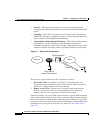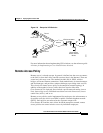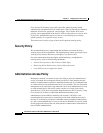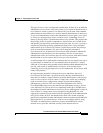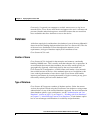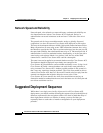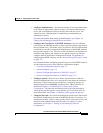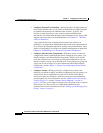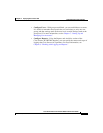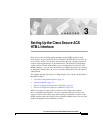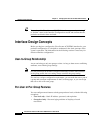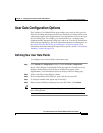
2-19
Cisco Secure ACS 3.0 for Windows 2000/NT Servers User Guide
78-13751-01, Version 3.0
Chapter 2 Deploying Cisco Secure ACS
Suggested Deployment Sequence
• Configure Administrators—You should configure at least one administrator
at the outset of deployment; otherwise, there is not remote administrative
access and all configuration activity must be done from the server. You
should also have a detailed plan for establishing and maintaining an
administrative policy.
For more information about setting up administrators, see Chapter 10,
“Setting Up and Managing Administrators and Policy.”
• Configure the Cisco Secure ACS HTML Interface—You can configure
Cisco Secure ACS HTML interface to show only those features and controls
that you intend to use. This makes using Cisco Secure ACS less difficult than
it would be if you had to contend with multiple parts of the HTML interface
that you did not plan to use. The price of this convenience can sometimes be
frustration that features and controls do not appear because you failed to
configure them in the Interface Configuration section. For guidance on
configuring the HTML interface, see the “Interface Design Concepts” section
on page 3-2.
For information about configuring particular aspects of the HTML interface,
see the following sections of the interface configuration chapter:
–
User Data Configuration Options, page 3-3
–
Advanced Options, page 3-4
–
Protocol Configuration Options for TACACS+, page 3-7
–
Protocol Configuration Options for RADIUS, page 3-10
• Configure System—There are more than a dozen functions within the
System Configuration section to be considered, from setting the format for
the display of dates and password validation to configuring settings for
database replication and RDBMS synchronization. These functions are
detailed in Chapter 8, “Establishing Cisco Secure ACS System
Configuration.” Of particular note during initial system configuration is
setting up the logs and reports to be generated by Cisco Secure ACS; for
more information, see Chapter 9, “Working with Logging and Reports.”
• Configure Network—You control distributed and proxied AAA functions in
the Network Configuration section of the HTML interface. From here, you
establish the identity, location, and grouping of AAA clients and servers, and
determine what authentication protocols each is to employ. For more
information, see Chapter 4, “Setting Up and Managing Network
Configuration.”




